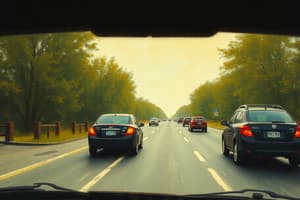Podcast
Questions and Answers
What are divided highways?
What are divided highways?
- Highways with no barriers
- Roadways specifically for trucks
- Where a wall or retainer is dividing the traffic in opposite directions (correct)
- Highways with multiple exits
What characterizes laned roadways?
What characterizes laned roadways?
They have at least 2 clearly marked lanes for traffic going in one direction.
What is the purpose of the left or 'fast' lane in three-laned highways?
What is the purpose of the left or 'fast' lane in three-laned highways?
It is used for faster traffic, called the 'number one lane'.
How should you choose a lane?
How should you choose a lane?
HOV lanes are restricted to vehicles with one occupant.
HOV lanes are restricted to vehicles with one occupant.
You should stay in the ________ of your lane to travel safely.
You should stay in the ________ of your lane to travel safely.
Where should you position your vehicle on narrow roadways?
Where should you position your vehicle on narrow roadways?
What should you do when driving on mountain roadways?
What should you do when driving on mountain roadways?
What should you do when other vehicles are approaching?
What should you do when other vehicles are approaching?
When passing a vehicle, you will cross over onto the opposing traffic's lane of travel, so use ________.
When passing a vehicle, you will cross over onto the opposing traffic's lane of travel, so use ________.
Under what circumstances can you drive on the left side of the roadway?
Under what circumstances can you drive on the left side of the roadway?
Why are left lanes used on highways?
Why are left lanes used on highways?
What is required of slow-moving vehicles when they have five cars behind them?
What is required of slow-moving vehicles when they have five cars behind them?
Special vehicles are allowed to use all lanes on three and four-way highways in California.
Special vehicles are allowed to use all lanes on three and four-way highways in California.
What should you do if you are traveling slower than the normal speed of traffic?
What should you do if you are traveling slower than the normal speed of traffic?
Flashcards are hidden until you start studying
Study Notes
Driving Lane Use
-
Divided Highways: Features a physical barrier separating traffic moving in opposite directions, enhancing safety.
-
Laned Roadways: Defined by at least two clearly marked lanes for traffic in one direction, separated by double or single yellow lines, which can be broken or unbroken.
-
Three-Laned Highways: Consist of three lanes moving in the same direction; the left is the "number one lane" (fast lane), while the right lanes are termed as number two and three.
Lane Selection
-
Choosing a Lane: Opt for the lane with the best traffic flow; typically, the middle lane is optimal for smooth driving. Use the left lane for passing or turning quickly, and the right lane when traveling slowly or preparing to exit.
-
HOV Lanes: High-occupancy vehicle lanes designated for cars with two or more passengers, effectively promoting carpooling.
-
Marked Lanes: Position your vehicle centrally within marked lanes to ensure safe travel and clear visibility.
Roadway Characteristics
-
Narrow Roadways: Keep vehicles positioned far right and reduce speed to navigate safely without hazards.
-
Mountain Roadways: Drive to the far right, use headlights in low visibility, and honk on curves for safety.
Interactions with Other Vehicles
-
Other Vehicles Approaching: When encountering oncoming traffic or a vehicle passing, adjust your position to the far right of your lane.
-
Passing Vehicles: Expect to temporarily cross into the opposing traffic lane on multi-lane highways; extreme caution is essential.
Exceptions and Special Cases
-
Exceptions to Right Side Driving:
- Turning left at intersections or private roads.
- When the right side of the road is blocked.
- On one-way roads.
- In narrow road conditions.
- Adverse weather conditions or road markings requiring a lane change.
-
Left Lanes: Utilized for making left turns from highways, promoting traffic flow and reducing collisions. Turn-Out lanes on narrow roads allow slower vehicles to let faster traffic pass safely.
Specific Vehicle Regulations
-
Slow-Moving Vehicles: Must utilize the right-hand lane unless overtaking or passing another vehicle in the same direction.
-
Left Turns: Employ designated left turn lanes at intersections to ensure orderly traffic flow.
-
Use Turn-Outs: Vehicles traveling slower than the normal speed and having five or more vehicles behind them are required to use turn-outs to facilitate smooth traffic flow.
-
Special Vehicles: Large trucks on 3 and 4-way highways in California are restricted to the two rightmost lanes for safety and to minimize disruptions.
-
Left Lane Usage: Typically moving faster than the right lane; vehicles traveling slower than normal speed should remain in the right lane to maintain safety.
Studying That Suits You
Use AI to generate personalized quizzes and flashcards to suit your learning preferences.




